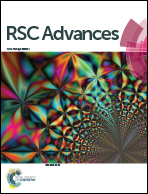Preparation of monodispersed CuS nanocrystals in an oleic acid/paraffin system†
Abstract
Well-dispersed CuS nanocrystals were synthesized through a simple hot injection approach using cupric oxide and elemental sulfur as the precursors in an oleic acid/liquid paraffin system. The structural, morphological and optical properties of the as-prepared nanocrystal CuS samples were characterized by transmission electron microscopy, X-ray diffraction, X-ray photoelectron spectroscopy, ultraviolet-visible and near-infrared spectrophotometry, and room-temperature photoluminescence (RT-PL). The band gap of the CuS samples were estimated from the ultraviolet-visible spectra. The formation mechanism of monodispersed CuS nanocrystals in an oleic acid/liquid paraffin system was proposed. The cleaning agents have an important influence on the final morphology of the CuS nanocrystals, and pure hexagonal covellite CuS NCs can be obtained by controlling the ratio of Cu2+ : S2− = 1 : 1. The as-prepared CuS nanocrystals with the narrow band gap reveal dramatically broad absorption bands in the visible-light and near-infrared (NIR) region, exhibiting promising applications in photovoltaic cells, electrochemical sensors and photocatalysts.


 Please wait while we load your content...
Please wait while we load your content...